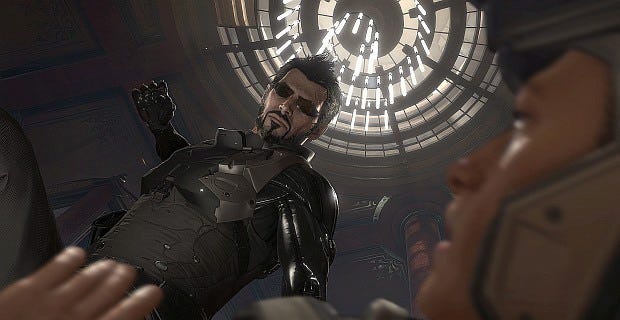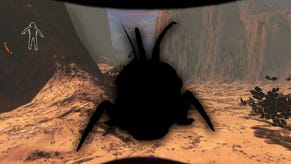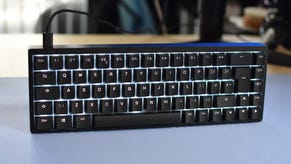Deus Ex Mankind Divided Hands On: "All Signs Suggest It's An Improvement On Its Predecessor In Every Way"
Praxis Makes Perfect
I’m in the camp that thought Deus Ex: Human Revolution was a hell of a good starting point. The level design ran up against apparent technical limitations, chopped into distinct sections rather than flowing naturally from streets to interiors and back again, and the stealthy approach sometimes felt more difficult than it should have been thanks to sticky cover and too-rigid AI.
During a day of hands-on experience with follow-up Mankind Divided, it became apparent that Eidos Montreal felt similarly about their first stab at their cyberpunk revival. Moving from the tech renaissance of Human Revolution, the sequel steps into a fractured world of corporate feudalism. It’s looking superb.
Like the body of its protagonist, the locations of Deus Ex: Mankind Divided [officical site] have been gutted, hollowed out and repurposed. Eidos Montreal allowed us free reign to explore two locations in their upcoming sequel and all of the evidence points toward a more confident and reactive approach to first-person shooting and sneaking.
The first of those locations, an unfinished luxury hotel in Dubai, acts as tutorial and not-so-gentle introduction. I died four times before reaching a chaotic ending in which a sandstorm engulfs the area, covering the arrival of a new faction whose augmented aggression put paid to my perfect stealth run.
As well as leading newcomers through the basics of the various optional approaches that are at the heart of the game - stealthy slaughter, guns blazing, sneak and subdue, leave no traces - Dubai is a showcase for Mankind Divided’s reworked cover and power mechanics. Use of cover hasn’t changed dramatically but, as with every action in the game, the implementation is smoother and less prone to error. At the click of a button or push of a trigger, Jensen moves efficiently from one position to the next and doesn’t feel as if he’s velcroed into place as soon as he attaches to a waist-high wall or desk. The HUD displays the path he’ll take between pieces of cover and if you choose to dash into the open, it’s possible to see the exact spot you’ll reach.
As well as making all of Jensen’s movements flow more naturally, the new engine better facilitates the kind of positional awareness that the third-person camera was implemented to support. Your mistakes are choices rather than a result of grappling with a cumbersome avatar - sometimes those choices are made in a split second under extreme duress, but they’re made with full access to information about possible consequences.
Augments have also been tweaked and the intent behind the changes seems to stem from the same philosophy that is driving the tighter controls. Eidos Montreal are providing Jensen - and by extension, the player - with an array of tools and toys, and they are ensuring there is space to play with them. Energy levels aren’t as restrictive as in Human Revolution and stringing together a series of augmented movements, attacks and hacks is much more feasible. Jensen isn’t quite a Duracell Man but nor is he the disappointing action figure, batteries not included.
As I played through the second area, the surroundings and interior of a criminal headquarters within a derelict theatre in Prague, I relied on augmented abilities at almost every turn. Whether cloaking within a toilet cubicle for a few nerve-wracking seconds as a guard pried the door open and checked inside, or using the new Icarus Dash (a less flexible and disruptive take on Dishonored’s Blink) to travel invisibly between conversing soldiers, I found a cybernetic solution to almost every obstacle.
In short, the combination of controls that are more responsive and energy management that is less punishing made risk-taking more attractive, opening up the freedom of approach that is central to the series’ core philosophy. I was reminded of another sequel - Bioshock 2’s improved access to Plasmids, which encouraged experimental play as opposed to the original’s restrictive swapping and changing.
None of the above would be worth more than a moment’s notice if Mankind Divided didn’t show improvement in other areas. Working in tandem with what appears to be a convincing rethink regarding level design, however, the rebooted Adam Jensen is a marvel. Where Human Revolution’s spaces were constructed like a series of individual boxes connected by corridors, Mankind Divided’s hubs are like blocks of Swiss Cheese.
Approached from the city hub, the Prague theatre has four access points, from alley, street, sewer and rooftop. If every mission location slots into the wider world in this way, rather than having a distinct beginning and ending with attached loading screen, there will be a much stronger sense of existing within living areas.
Following the transition inside, every layer of the theatre, from the outside to the deepest point of the interior, offers alternative routes. Whether dealing with a patrolling sentry bot or a locked door, I never had to fall back on a solution that didn’t fit my particular play style. In fact, in one afternoon I managed to test every approach I could think of, including several extreme solutions to problems of my own making.
The build had three pre-configured Jensens to choose from, which made sense given that the theatre is part-way through the game and we’d skipped ahead after the tutorial. Using the Combat build, which had limited hacking or stealth capabilities, I managed to ghost through the entire level using barely any augmentations at all. Unseen and undetected, I then tried to work back through, from the target to street level, killing every NPC in the building.
Think of it as the equivalent of taking a car for a test drive. I was putting the level through its paces to see if it reacted as well to my preferred non-violent approach as it did to a shoot-out. As a stealth game, Mankind Divided already feels exemplary. Slight changes to visual feedback and enemy barks make AI behaviour more convincing and legible, but it’s in the level design that the game really shines.
An enormous amount of care has gone into making the theatre feel like a natural place, where vents exist as parts of the architecture, with utility and purpose, rather than convenient shortcuts. It’s almost possible to move from the beginning of the level to the end without leaving cover but such a route is reliant on clever use of Jensen’s abilities rather than opportune waist-high walls. Given a few hours to play with, I even managed to gather thirty-six unconscious guards in one room (well, thirty-one unconscious and five dead - mistakes were made) having nearly perfected my stealth run.
Gunplay is solid if unspectacular. There’s little in the way of visual feedback to communicate the chaos of an unexpected firefight, either through particle effects or enemy reactions, but the AI is effective, calling for assistance and tracking Jensen’s movement based on his last known position.
With only a tutorial - which is admittedly a flexible and enjoyable tutorial - and a single, small area as evidence, it’s impossible to know whether this quality will hold throughout the game, but if it does, Mankind Divided might well win over even those who rejected Human Revolution entirely. I like to refer to multifunctional augmented characters like Adam Jensen and JC Denton as Swiss Army Knives, equipped with various tools for whatever problem arises.
With his carve-happy fist-chisels, Jensen fits the bill perfectly. Now, at peace with his power, on the surface at least, he is content to be a weapon, either deployed by new agencies to keep the peace in a world at war with itself, or striking surgically from the dark while following his own agenda. In a player’s hands, he is adaptable but the freedom of approach that he represents is only as useful or relevant as the environment to which it is applied.
Mankind Divided may well be the game that lives up to its protagonist, both in plotting and in action, but everything depends on the quality of those environments. In the small slice I’ve seen, that repurposed theatre is reminiscent of Blood Money’s density and the warm glow of a deteriorating Dubai, that all the signs suggest this will be an improvement on its predecessor in every way.
We'll have more features about the art design and plot of Deus Ex: Mankind Divided in the days ahead.













